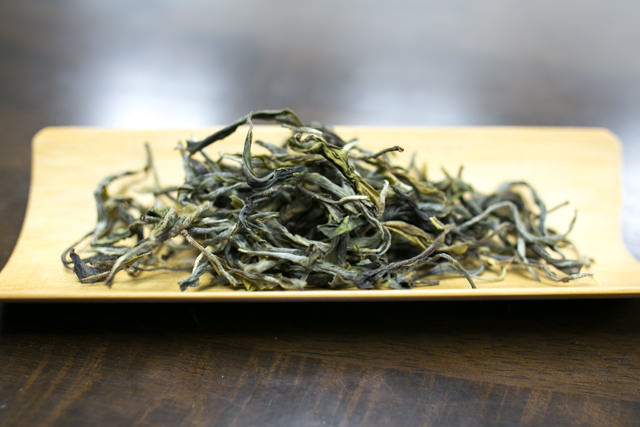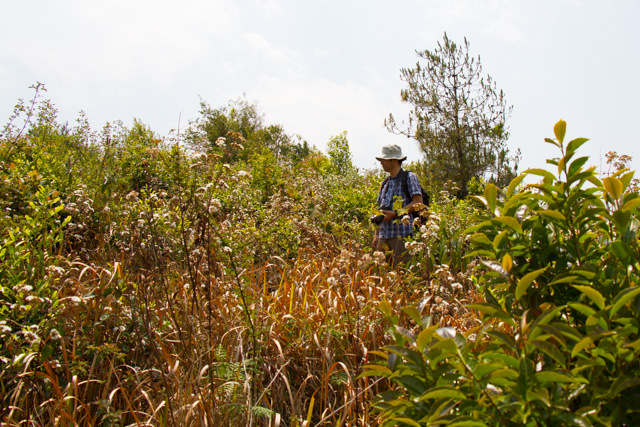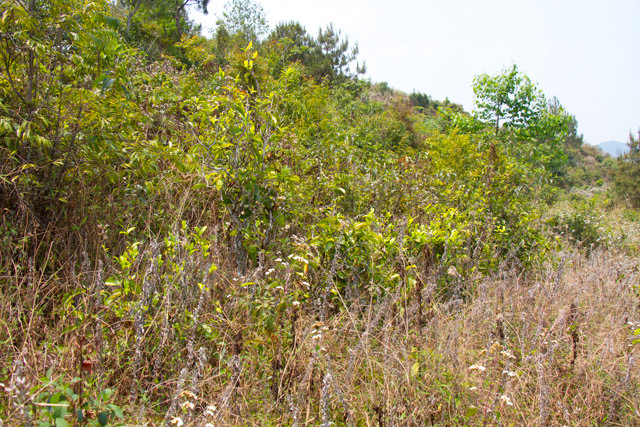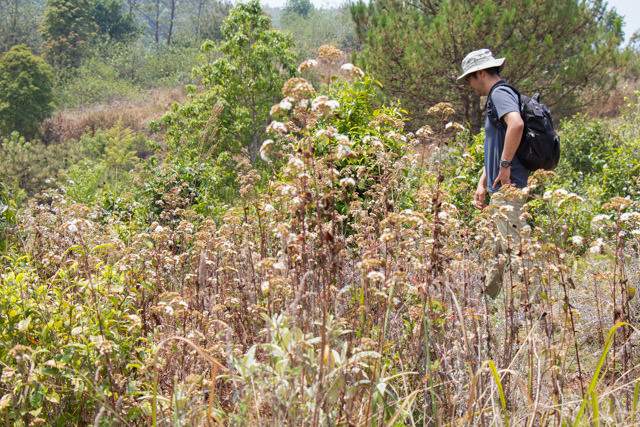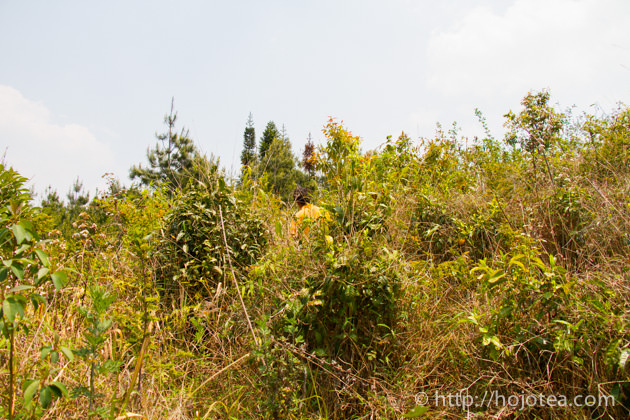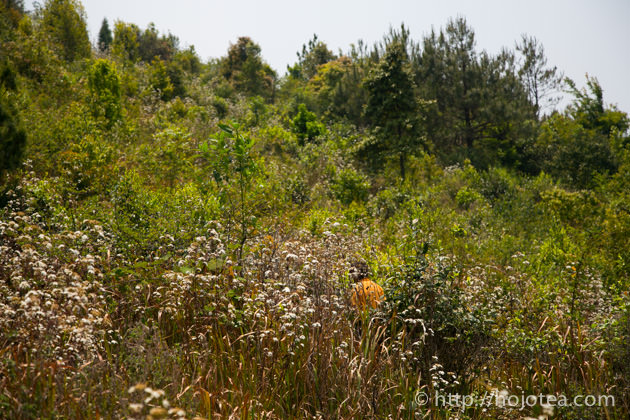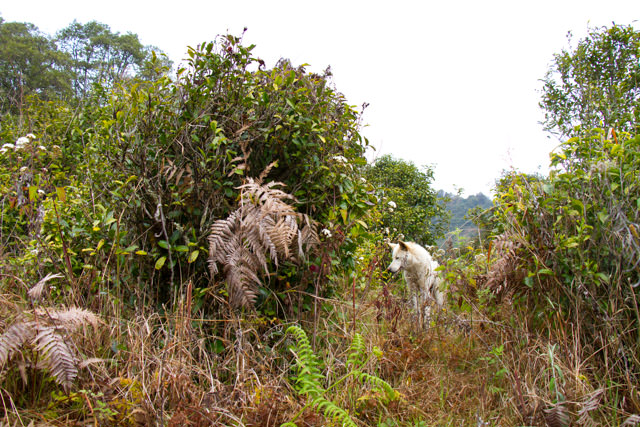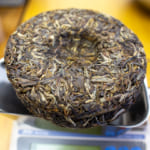- HOME >
- New Arrival at HOJO Online Shop
Pre-booking of Geng Ma Pu-erg tea made with green tea pan-frying style
- [2017.05.12] Posted By Akira Hojo

I have been aware that the naturally grown tea, in particular, the freshly plucked tea from the wild tea garden gives very strong floral scent; moreover it has very less bitterness and astringency. In order to amplify these cup characteristics, we used special pan-frying method in order to dry the leaf swiftly and remain the flavor of the fresh leaf. Since we are delighted with the outcome, we wish to share some mao-cha on pre-booking basis.
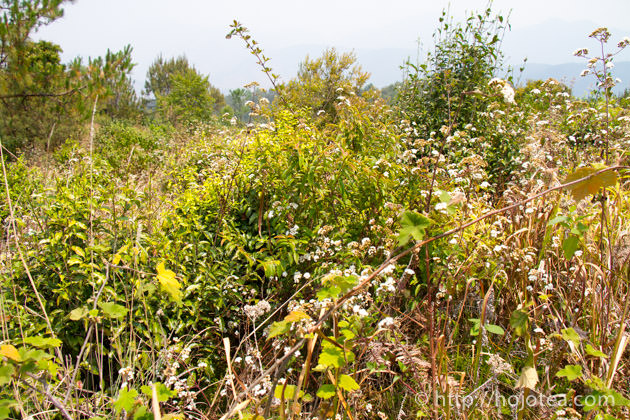
Development of raw pu-erh tea that gives refreshing flavor
As we know, quality pu-erh tea gives pleasant drinking sensation with smooth and soft mouth feel. However not everyone immediately appreciate the flavor of pu-erh tea. One of the reasonss is that the flavor of the freshly produce pu-erh tea is very mild and gentle. We wanted to make its flavor to be stronger and more appealing so that more people start liking the fresh raw pu-erh tea.
We have spent some time to develop the flavorful pu-erh tea. One of our achievements was the long withered raw pu-erh tea that we explained in the previous post.
Nevertheless, this year, we developed another tea with special pan-frying method in order to bring up the refreshing flavor of the fresh tea leaf.

Pan-frying technique learned from making green tea
The pan-frying is to evaporate the moisture of tea leaf and let the saturated steam inactivates the enzyme of tea leaf. In Yunnan, most of tea manufacturers will set lower temperature, load a lot of tea leaf and tea is less frequently flipped, as they want to generate more steam and let the steam saturate longer in between tea leaves. This method is very effective and steady to inactivate the enzyme. Due to longer steaming effect, in most cases, the flavor of pu-erh tea becomes milder. (Though it is not a problem for normal raw pu-erh tea. )
Unlike the common method, we used the Chinese green tea pan-frying style for making the raw pu-erh tea. Our tea manufacturer used higher temperature, loaded less tea leaves and very frequently flipped the leaves in order to speed up the evaporation of steam. This method reduces the moisture of tea faster and it preserves the flavor of tea fresh.

The crucial part is to make sure inactivate the enzyme in the tea stems, yet reduce the moisture of tea leaf during pan-frying process. So far very few people in Yunnan tried this technique as it is quite difficult to manage. In addition, this processing method is not suitable for common tea. It gives very bitter and astringent taste, and the flavor becomes very greenish. This is because of for pu-erh tea, the plucking standard is normally 1 bud and 3-4 leaves while the leaf for making green tea is much younger (usually 1 bud with 1-2 leaves). Since the quality of fresh tea leaf is directly affecting the drinking sensation, it was very important for us to choose the naturally farmed tea that taste is less bitter, less astringent and not greenish but floral.
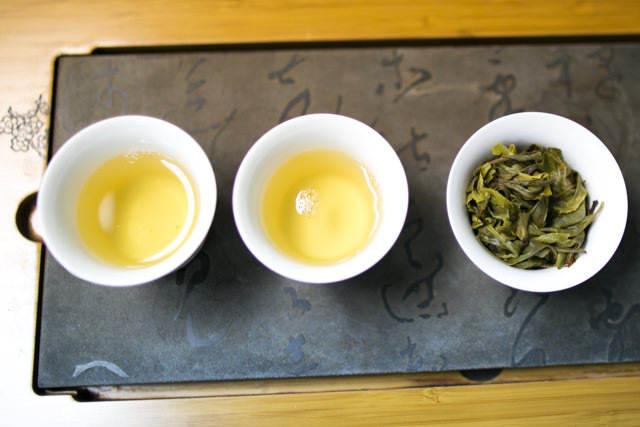

Use the tea collected from wild tea garden
After spending a lot of time to look for the right quality, we selected the wild tea garden (野放茶園) located in Geng Ma (耿马), in Lincang, Yunnan. Wild tea garden refers to the garden that were left in the wild growing environment for a long time and eventually tea trees are back to wild. In addition, the frequency of tea plucking is also an important criterion. We choose the garden that tea plucking is conducted only once a year. As tea trees spend a long time to grow, the distance between each leaf on the twig is very short. Those tea leaves are very rich in minerals and poly phenols content.

Unlike common tea, the fresh tea leaf from the wild garden gives extraordinarily strong floral scent even when tea leaf is intact. The floral scent is very appealing when tea is just plucked, while the tea from the common tea garden gives less floral but greenish scent. Honestly, I am happy to just directly put these fresh tea leaves from the wild tea garden into hot water and drink it as it is.
The trend on old tea tree is slowing down, while the naturally-farmed tea is on the uptrend now
In China, it has been a trend that people sought after the pu-erh tea made of old tea tree. In the past decade, everyone including manufacturers, farmers and customers were enthusiastically talking about the old tea tree. The word Gu Shu (古树) or Lao Shu (老树) (it means old tea bush) was used as a synonym for pu-erh tea in China. However, people started to realize that too many old tea trees are over fertilized.
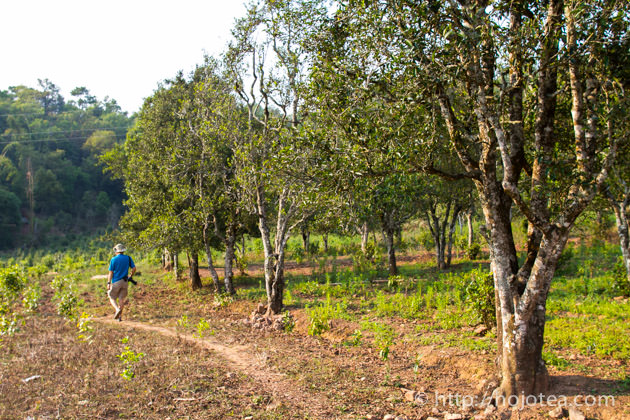
The above photo shows the old tea trees that are huge but fertilized.
Through my observation, the trend of old tree pu-erh tea is now gradually slowing down in China. Instead, I observed that more and more people are looking for the naturally farmed tea. The price of fresh tea from those natural gardens using no chemicals and no fertilizers is steadily increasing. We often need to compete with other tea buyers in order to secure the desired material. In particular, the fresh tea leaf from those wild tea gardens is of high demand. Lately, there are increasing number of people come to Lincang region to search for the naturally-farmed tea. Nowadays, they show less interest on famous tea production area but to focus on naturally-farmed tea garden.
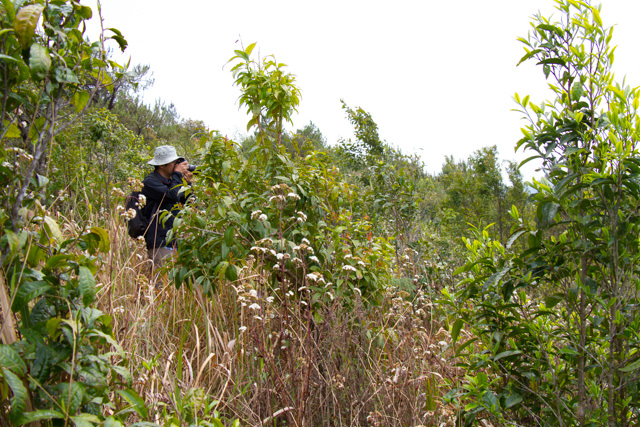
Clean and extraordinary long lasting flavor
This tea is suitable for further aging since the tea stems were well pan-fried and no semi-fermentation took place during sunshine drying process. Nevertheless, I love to share the mao-cha first since it gives fresh flavor. The flavor profile may differ depending on the water quality. I felt that the flavor of this tea was floral and very refreshing when I brewed this tea in Yunnan. Its flavor reminiscent the light-fermented Taiwan oolong tea. When I brewed it again in Japan it was like the famous Chinese green tea, Tai Ping Hou Kui. I enjoyed the subtle greenish floral note that lingers down throat.
Besides the distinctive flavor, this tea is thick in taste. It gives full-bodied and extra ordinarily long lasting aftertaste. One of our existing tea lineup, Ma An Shan raw pu-erh has been a very popular tea because of its strong body and aftertaste. The Geng Ma Raw Pu-erh tea gives equally bold and well-balanced drinking sensation. In addition, this tea has a clear taste. If you care about the clarify in taste, this is the tea we highly recommend.
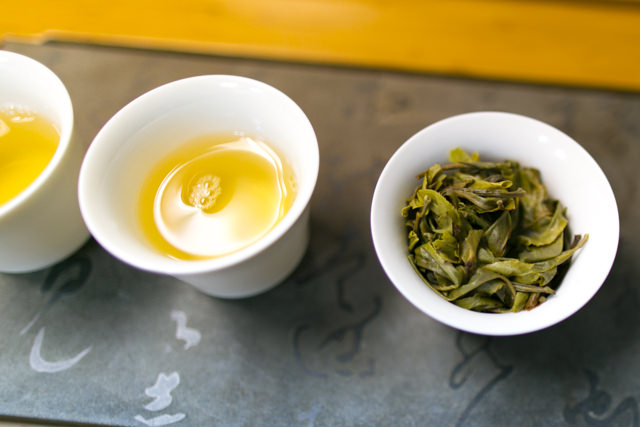
Unlike common pu-erh tea, Geng Ma Raw Pu-erh Tea gives a little orangey liquor.
Pre-Booking for Mao-Cha
If you are interested to book this tea, please send us an e-mail or Facebook message.
100g JPY3,500
200g (100g x 2) JPY6,800
600g (100g x 6) JPY19,900
1000g (100g x 10) JPY28,000
For customers residing in Malaysia, please visit the following website for the price in MYR.
https://hojotea.com.my/posts-162/
In fact, the cost of Geng Ma Raw pu-erh tea is equally high as Ma An Shan. This is the first time we introduce this tea and we wish to share it with more people. As such, the price for this pre-booking Mao Cha is set lower than Ma An Shan tea. If you are a person who enjoy light fermented oolong tea or green tea and wish to widen your tea drinking experience to the next level to have tea with full-bodied and long-lasting aftertaste, it can be a good try.
Related Articles
How to get the latest update on HOJO?
1. Follow Twitter, 2. Click "Like" on Facebook, and 3. Subscribe in newsletter. You can have the latest tea news from HOJO.
 Subscribe the Newsletter to enjoy the privileges
Subscribe the Newsletter to enjoy the privileges- You may receive a free sample upon purchase, or you may have the priority to purchase special products. So please remember to subscribe our newsletter as well as the social network.
- New Arrival of Akitsu Mumyoi and Nosaka Rough Clay Teapot
- A wide selection of teaware by Watanabe Tozo, a Sado-based artist of Mumyoi-yaki, has just arrived. This time, …
- Mang Fei Ripe Pu-erh Tea 2023 – Small-Batch Production from a Renowned Region
- Mang Fei Ripe Pu-erh Tea 2023 is now available. This is one of the highest-quality ripe pu-erh teas among our …
NEW ARTICLES
 Development of Firewood Roasted Hojicha Using Naturally Grown Tea from Yunnan
Development of Firewood Roasted Hojicha Using Naturally Grown Tea from Yunnan- We are currently staying in Yunnan Province for tea production. As the season nears its end, tea trees with pa …
 Exploring the Food Culture of Yunnan: Where Minority and Sichuan Cuisines Meet
Exploring the Food Culture of Yunnan: Where Minority and Sichuan Cuisines Meet- We are currently staying long-term in Yunnan Province for spring tea production. On rainy days or when there i …
 New Arrival of Akitsu Mumyoi and Nosaka Rough Clay Teapot
New Arrival of Akitsu Mumyoi and Nosaka Rough Clay Teapot- A wide selection of teaware by Watanabe Tozo, a Sado-based artist of Mumyoi-yaki, has just arrived. This time, …
 Managing Yunnan White Tea — Insights from the Field
Managing Yunnan White Tea — Insights from the Field- Since March 25, we have been in Yunnan Province, fully engaged in the production of white tea. In this column, …
 Mang Fei Ripe Pu-erh Tea 2023 – Small-Batch Production from a Renowned Region
Mang Fei Ripe Pu-erh Tea 2023 – Small-Batch Production from a Renowned Region- Mang Fei Ripe Pu-erh Tea 2023 is now available. This is one of the highest-quality ripe pu-erh teas among our …
 Yunnan Tea Trends 2025: Insights from the Fields
Yunnan Tea Trends 2025: Insights from the Fields- Since March 25, we have been in Yunnan Province. We will stay here until May to conduct tea production, packin …
 Why Do Some Teas Taste Astringent? Exploring the Causes and Mechanisms of Astringency
Why Do Some Teas Taste Astringent? Exploring the Causes and Mechanisms of Astringency- Tea can range from having no noticeable astringency to possessing a very strong one. What causes this astringe …
 The Impact of Heat Sources on Tea Flavor
The Impact of Heat Sources on Tea Flavor- It is widely recognized that the material of a kettle plays an important role in shaping the taste of water fo …
 New Release of Tang Li Shan Ripe Pu-erh Tea 2023
New Release of Tang Li Shan Ripe Pu-erh Tea 2023- We have released the 2023 edition of Tang Li Shan Ripe Pu-erh Tea. Tang Li Shan refers to a mountain located o …
 The New Release of Dong Shan Raw Pu-erh Tea 2023 and Jasmine Silver Needle
The New Release of Dong Shan Raw Pu-erh Tea 2023 and Jasmine Silver Needle- We have released Dong Shan Raw Pu-erh Tea 2023 and Jasmine Silver Needle. Dong Shan Raw Pu-erh Tea 2023 We hav …
Category
- New Arrival at HOJO Online Shop
- Featured Articles
- Newsletter
- Types of Tea
- Origin of Tea
- Teapot and Tea Equipment
- Tea Column
- How to enjoy tea
- Tea Processing
- How to choose quality tea
- Tea constituents and functional effect
- Safety of Tea
- Foods
- Tea Business Operation
- Hobby and Outdoor Activity
- Ranking of Tea
- Video
- FAQ
- Media Release
Profile

- AKIRA HOJO
- I invite you to experience my tea selections.I was born in Nagano, Japan. In university, I studied agricultural chemistry, and I have the master degree in food science. I worked in Japanese food industry for 10 years. I involved in R&D, QC and QA. As a factory manager, I implemented ISO9000 series and managed the factory.
- The Art of Tea Magazine
- We posted the article on “The Art of Tea Magazine No.9, the magazine is published in Taiwan. We featured …
- New Straits Times
- The Malaysian National Newspaper, New Straits Times featured HOJO Tea on 17-Oct-2007.
Shop Info

Address:Lot No. T-215, 3rd Floor, The Gardens Mall, Mid Valley City, Lingkaran Syed Putra, 59200 Kuala Lumpur
Tel: +603-2287-4537
Business Hour: 10am to 10pm

